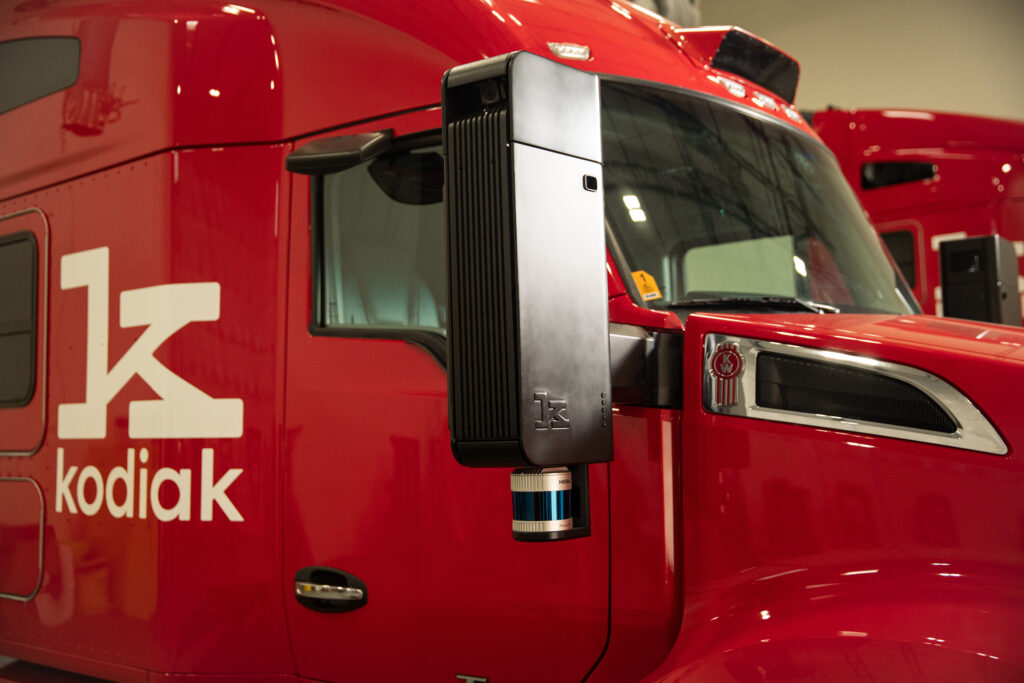Californian self-driving truck company Kodiak Robotics has revealed its fourth-generation autonomous truck, complete with a sensor suite comprising a Luminar Iris lidar, ZF full-range radar, and Hesai 360° scanning lidars for side- and rear-view detection, all connected to an Nvidia DRIVE platform. The new rigs also feature smart-sensing tire technology from Bridgestone Americas. The fourth-generation trucks will hit US highways from Q4 of 2021, as Kodiak begins to take delivery of 15 new tractors.
The modular and discreet sensor suite sees a slim profile ‘center pod’ on the front roofline of the truck, and pods integrated into both of the side mirrors. Kodiak says this arrangement vastly simplifies sensor installation and maintenance, and increases safety, with the new trucks designed with greater fleet uptime, manufacturing and serviceability in mind – all of which are critical to scale quickly, safely and efficiently.
“Complex and bulky systems that require an engineer to hand-build and hand-tune are expensive, unreliable, and difficult to debug,” said Don Burnette, co-founder and CEO of Kodiak Robotics. “We believe that reliability and scalability flow from simplicity, and the best hardware modifications should be barely visible. Our fourth-generation platform is designed for simple, scaled production which means easy calibration, troubleshooting and maintenance for our partners.”
Kodiak Vision
Kodiak’s perception system, Kodiak Vision, considers every sensor – including lidar, camera and radar – as ‘primary’. Kodiak Vision fuses together the information from the sensors and considers the relative strengths and weaknesses of each type. This incorporates extra redundancies and cross-validates data, adding another layer of safety to the self-driving system, according to the company.
Kodiak says its fourth-generation truck further improves Kodiak Vision’s performance and reliability by incorporating the ZF full-range radar and Luminar’s long-range Iris lidar. These sensor integrations, combined with Kodiak’s integration with Hesai 360° scanning lidars, for side- and rear-view detection, provide the necessary automotive-grade reliability needed for long-haul trucks.
The four-dimensional (4D) ZF full-range radar measures the distance, height, lateral angle and velocity of an object out to more than 300m. This contrasts with traditional radar, which cannot measure the vertical position of an object, effectively viewing the world from the top and down like a map. 4D radar is critical for autonomous trucks because it allows the system to distinguish overhead objects – such as road signs and bridges – from road hazards like stopped vehicles under a bridge or an overhead sign.
Luminar’s new automotive-grade Iris lidar’s wide horizontal and vertical field of view enables Kodiak trucks to recognize objects both near and far, adding further redundancy for long-range detections up to 600m. The high resolution and range allows the system to reliably ‘see’ objects such as pedestrians and motorcycles. The lidar’s slim design has a profile of just 10cm, ensuring easy integration into Kodiak Robotics’ discreet center-roof pod, in the front of the truck.
Kodiak Robotics’ patent-pending mirror pods, which will start with one Hesai lidar, two long-range 4D radars and three cameras, don’t require specialized sensor calibration for easy upfit and repair. Rather than replacing a sensor in need of maintenance, a mechanic can simply replace the mirror pod in a matter of minutes. This single point of integration will allow maintenance and serviceability at scale.
The new trucks will eventually feature Nvidia’s ISO 26262 ASIL-D-compliant Drive Orin supercomputing platform, once available, capable of providing more than 250 TOPS (trillion operations per second) of compute performance. In the interim, Kodiak will use the current generation Nvidia Drive AGX Pegasus to process the data from the cameras, allowing the autonomous system to perceive the surrounding environment.
Fleet size to double
Kodiak has placed an order for an additional 15 PACCAR trucks that will be delivered over the next year. The trucks will more than double the company’s fleet size and help Kodiak expand its growing business delivering freight for commercial customers in Texas and beyond. Over the next couple of years, the company plans to expand throughout the southern half of the USA into other freight-rich corridors.
Kodiak trucks run exclusively on Bridgestone tires and will be equipped with Bridgestone cloud-connected sensors that capture critical tire-centric data. That data will be analyzed and processed into live actionable insights, increasing uptime, improving overall safety, and enhancing the operational efficiency of Kodiak’s automated systems.


